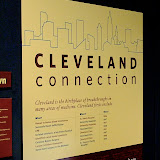 |
| Great Lakes Science Center |
The science communication starts even before you get inside the main body of the building. Within the car park are posted gigantic optical illusions, as well as some of the science behind how the centre is helping in the fight against climate change. This sets the whole visit off to a good start for me, because I like seeing a proactive centre trying to inform at every turn.
For every single exhibit and interactive there is a sign giving full information about what’s going on, what to look for and the principle behind it, thus giving visitors a simple, no-nonsense guide to the reasons for it being there. When describing the catenary arch, the equation y = -a cosh(x/a) was introduced and explained adequately, giving you the salient facts.
Moreover, the centre has taken great steps to make its interactives very simple. For instance, one of the very best I saw was a set of time-lapse photographs stretching back over a year that visitors could cycle through, viewing the weather at any time. Breathtakingly simple, but extremely effective: here you could see a year’s worth of weather, watch the lake being used by the ships and so on. This was magical.
The other big coup for the centre is that the Cleveland home of NASA is being closed down, and therefore that collection is moving into the building. Already the facility is being expanded and the space section is feeling the benefits of the merger. The rest of it will move in for a big opening in summer 2011, and the member of staff I spoke to was very excited about the news. The staff were good, informative and helpful to the degree you’d expect in a customer services role.
Other excellent exhibits that caught my eye included breadboards for learning about electronics simply and in a hands-on way, a sphere and a pyramid filled with balls along with a guide to estimating the number inside and a circular sheet of metal with triangular holes in for directing sunlight onto a surface, deftly showing how a triangle could produce a circular image.
There is a small, inflatable planetarium with a simple cylinder projection system, and also an Omnimax cinema. It doesn’t need to be repeated that I was extremely impressed, because I loved the signage and the simplicity – this truly was a great place for science communication and public interaction, and it can only get better with the inclusion of NASA’s collection too.



No comments:
Post a Comment